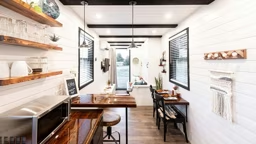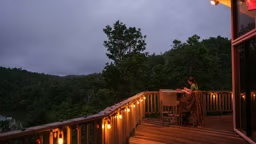1] Getting More for Less
What’s the easiest way to reduce the cost of your new cabin? Reduce its size.
Simple design techniques can transform a small space into one that feels more spacious. You can: use large windows and sliding doors to bring the outside in; increase ceiling heights; design an open floor plan with minimal interior walls; add window seats and alcoves, corner windows, small-scale furniture and choose light colors for walls and ceilings.
2] Soft Touch, Low Impact
Green building, clearly the hottest trend in residential design today, often focuses on reducing energy use — a practice that’s good for your pocket book as well as the environment.
An evolving understanding of the environmental impact of buildings and their energy use has resulted in a number of products and techniques.
Some are quite simple and obvious. A well-insulated building with quality windows is one of the best investments a cabin owner can make. Exterior window shades, trellises and deciduous trees to shade south-facing windows can reduce or eliminate the need for costly air-conditioning.
Compact fluorescent lights, Energy Star appliances, solar-assisted hot water heaters, and ultra-efficient heating systems are also good investments.
There are some new, fascinating, innovative green concepts and products too, such as:
- Rainwater harvesting — For example, see the system by Oregon-based landscape architect, Lando & Associates, www.lando-landscapearchitecture.com.
- Small-scale waste treatment – An example is the Brac gray water resuse system at www.bracsystems.com/home).
- Renewable energy – Wind, solar and geothermal power are really taking off. But have you seen the residential-scale fuel cell by Clear Edge Power (www.clearedgepower.com)? Simply put, this technology is about converting natural gas, propane, and eventually biofuels — into both electricity and heat. So a compact fuel cell could be an effective means of generating electricity, heat and hot water for a cluster of cabins with access to natural gas or propane.
3] I Want It Now
The 1950s-style convenience of mail-order homes through the Sears, Roebuck catalog has returned with a fresh crop of modular and prefabricated cabin manufacturers. The new pre-fabs sport contemporary designs, enhanced insulation, green materials and a wide variety of sizes to fit delicate sites and budgets.
Modular and pre-fabricated homes may be a good route if you want to build your cabin in a remote area that lacks a full complement of skilled tradesmen.
4] Indoors Out
Our cabins provide us with a retreat from our bustling modern lives. So it follows that a logical advance in cabin design is an array of features that put us in touch with the outdoors and each other, so we can reconnect and renew.
At the top of the list is the expanded use of outdoor rooms. Cabin dwellers have long known that an outdoor room creates low-cost living and entertaining space, and the idea has really caught fire and become a hot trend.
5] Going Natural
The use of natural materials in cabin construction and décor is no trend. Cabin builders and owners have long made use of natural materials — from rustic, twiggy railings to birch branch curtain rods to bent willow furniture to deer antler chandeliers to stone flooring to rock fireplaces. And when these items are harvested and created near your cabin that means lower transportation costs and a higher green factor.
You can vastly improve the indoor air quality of your vacation home by using materials that do not contain toxins, formaldehyde and volatile organic compounds.
Going green isn’t about jumping on the bandwagon of trendiness. It can pay off with a cabin that’s more comfortable, healthier and easier on the wallet. So free yourself to dream about building or renovating a vacation home that best fits you and your family.
Nathan Good — an architect in Salem, Ore., with projects throughout the western half of the U.S. and Mexico — also consults, writes and lectures about green homes.










